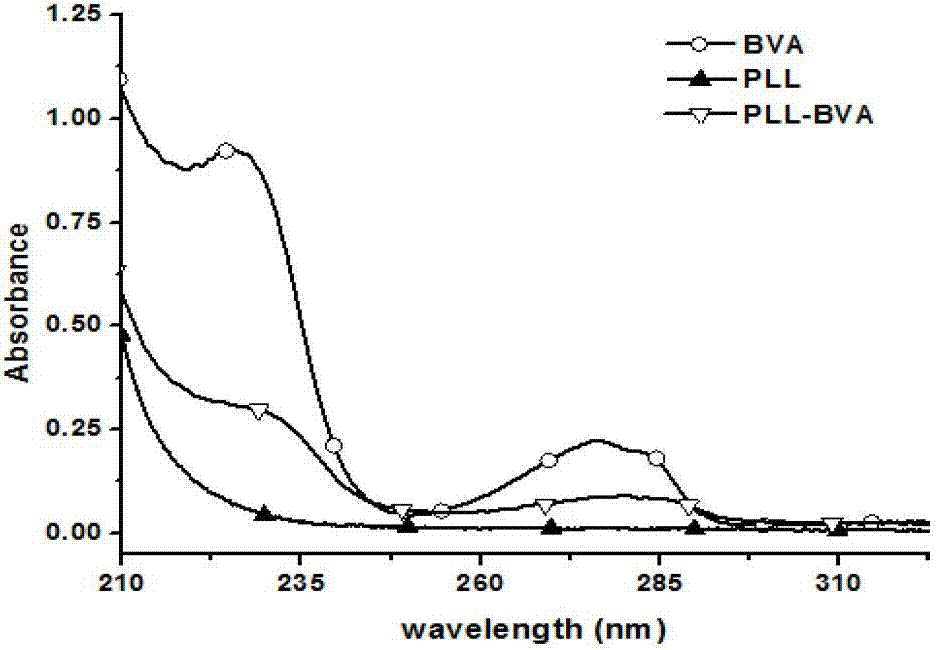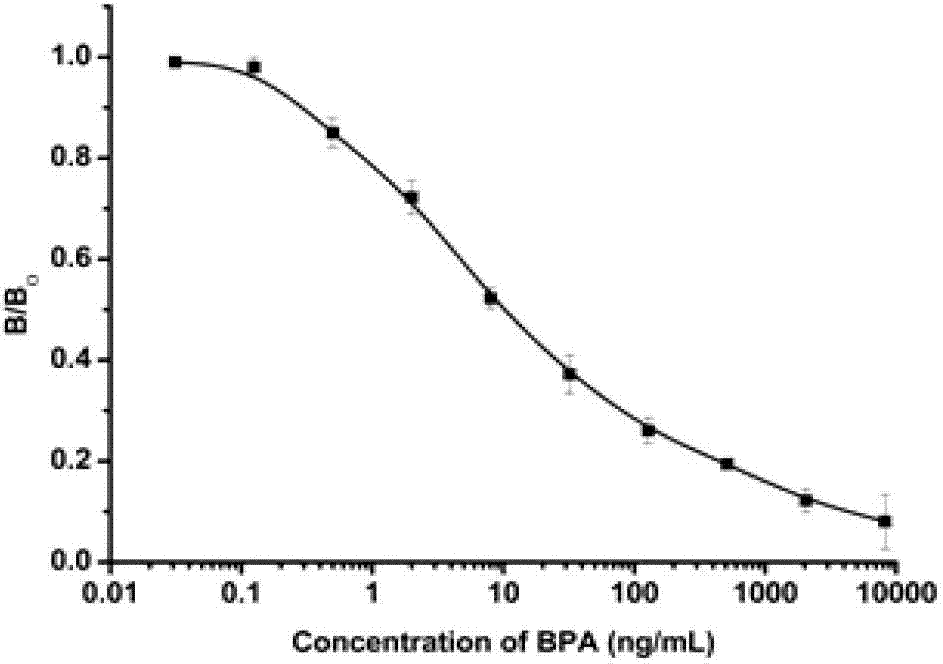Preparation method of bisphenol A-coated antigen with polylysine as carrier and application thereof
A technology of polylysine and antigen-coating, which is applied in the field of ELISA, can solve the problems of no bisphenol A artificial packaging, etc., and achieve the effect of facilitating coupling reaction, simple structure and wide sources
- Summary
- Abstract
- Description
- Claims
- Application Information
AI Technical Summary
Problems solved by technology
Method used
Image
Examples
Embodiment 1
[0027] Weigh 61 mg of bisphenolic acid (BVA) and dissolve it in 2 mL of DMF; then weigh 30.6 mg of NHS and 53.2 mg of EDC·HCL and dissolve them in 2 mL of (tetrahydrofuran) DMF, slowly add it dropwise to the BVA solution, and stir at room temperature for 24 hours in the dark. The supernatant was collected by centrifugation to obtain liquid A.
[0028] Weigh 126 mg of poly-L-lysine and dissolve it in 5 mL of pH=7 phosphate buffer solution to form B solution, take 4 mL of A solution and slowly add dropwise to B solution, stir at room temperature for 24 hours in the dark, centrifuge, and transfer the supernatant to The dialysis bag was dialyzed with a phosphate buffer solution of pH = 7.4 for 72 hours, and the dialysate was changed every 12 hours. Finally, the dialysate was freeze-dried to obtain the artificially coated antigen of bisphenol A, that is, PLL-BVA, and its structure was identified by ultraviolet spectroscopy. refer to figure 1 .
Embodiment 2
[0030] Weigh 20.7 mg of bisphenolic acid (BVA) and dissolve it in 1 mL of DMF; then weigh 6.6 mg of NHS and 14.2 mg of EDC·HCL and dissolve it in 1 mL (tetrahydrofuran) DMF, slowly add it dropwise to the BVA solution, and stir for 2 hours at room temperature in the dark , and centrifuged to get the supernatant to obtain liquid A.
[0031] Weigh 30.2 mg of poly-mixed lysine and dissolve it in 5 mL of phosphate buffer solution with pH=7 to form liquid B, take 3 mL of liquid A and slowly add it dropwise to liquid B, stir at room temperature for 2 hours in the dark, centrifuge, and transfer the supernatant To the dialysis bag, dialyze with pH = 7.4 phosphate buffer solution for 72 hours, change the dialysate every 12 hours, and finally freeze-dry the dialysate to obtain bisphenol A artificial coating antigen, namely PLL-BVA, and identify its structure by ultraviolet spectroscopy , see figure 1 .
Embodiment 3
[0033]Weigh 24 mg of bisphenolic acid (BVA) and dissolve it in 1 mL of DMF; then weigh 10 mg of NHS and 17.2 mg of EDC·HCL and dissolve them in 1 mL (tetrahydrofuran) DMF, slowly add it dropwise to the BVA solution, and stir at room temperature for 12 hours in the dark. The supernatant was collected by centrifugation to obtain liquid A.
[0034] Weigh 15 mg of poly-L-lysine and dissolve it in 5 mL of pH=7 phosphate buffer solution to form B solution, take 2 mL of A solution and slowly add dropwise to B solution, stir at room temperature in the dark for 12 hours, centrifuge, and transfer the supernatant to The dialysis bag was dialyzed with a phosphate buffer solution of pH = 7.4 for 72 hours, and the dialysate was changed every 12 hours. Finally, the dialysate was freeze-dried to obtain the artificially coated antigen of bisphenol A, that is, PLL-BVA, and its structure was identified by ultraviolet spectroscopy. refer to figure 1 .
[0035] Bovine serum albumin was selected ...
PUM
 Login to View More
Login to View More Abstract
Description
Claims
Application Information
 Login to View More
Login to View More - R&D
- Intellectual Property
- Life Sciences
- Materials
- Tech Scout
- Unparalleled Data Quality
- Higher Quality Content
- 60% Fewer Hallucinations
Browse by: Latest US Patents, China's latest patents, Technical Efficacy Thesaurus, Application Domain, Technology Topic, Popular Technical Reports.
© 2025 PatSnap. All rights reserved.Legal|Privacy policy|Modern Slavery Act Transparency Statement|Sitemap|About US| Contact US: help@patsnap.com


